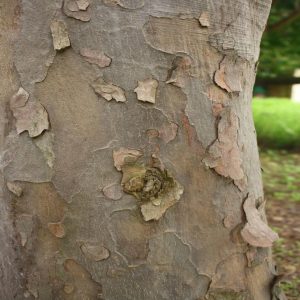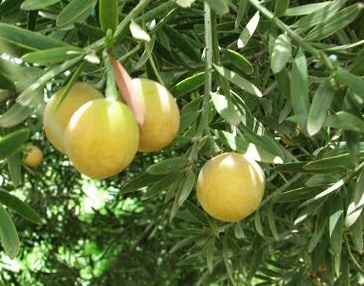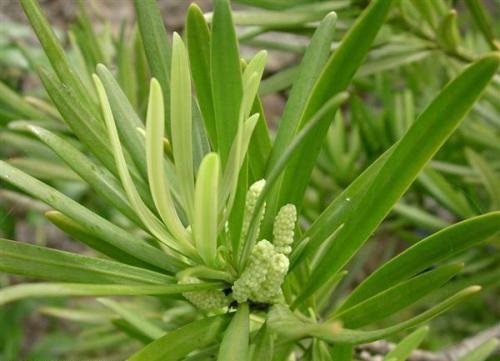Outeniqua Yellowwood – Podocarpus falcatus
(Kalander)
Outeniqua Yellowwood occurs from the South-Western Cape to the Transvaal and is a Protected Species.
The Tree
A medium-sized to very large tree – usually about 25m tall, and can grow up to more than 40m and reach 600-1000 years old. This is the tallest indigenous forest tree in South Africa. Its crown is often festooned with a lichen known as “old man’s beard” (Usnea barbata). This is the “Big Tree” of the Knysna forests. A few trees, such as the King Edward VIIth tree at Diepwalle and the Tsitsikamma Big Tree near Storms River bridge, have become major tourist attractions.The trunk can be up to 2m or more in diameter. The bark is in various shades of brown to purple, characteristically flaking in large, rectangular or circular, dark brown patches. Branchlets are square and deeply ridged.

The simple, alternate leaves are stiff and hard, twisted at the base and grow almost vertically from the twigs. They are narrow, straight or slightly curved – 30 to 50mm long and 2 to 5mm wide. The margins are parallel and are entire and the leaf-stalk very short, the leaf-tip sharply pointed. The leaves are dark green, often with greyish bloom. The colour is the same on both sides.
Male and female cones are found on separate trees – both occur in the axils of the leaf stalks. When a branch is shaken or raised by the wind, clouds of pollen can be seen. The female cones are round, consisting of minute fleshy scales. It has no fleshy receptacle. September – May.
The seed is found inside a large round fleshy covering which is up to 15mm in diameter, and is yellow when ripe. Fruit bats are the main dispersers, although the seed is also dispersed by the Knysna loerie and other birds, baboons and monkeys. Only during years of mass seed production, enough remain intact to germinate and develop into young trees. The fruit is edible, but resinous. Sterile fruit remains small, hard and bluish-green. Mainly December – January.
Properties
The timber is a light yellow colour, undifferentiated between heartwood and sapwood. It has a fine, even texture and a straight grain. It is light and fairly soft in sapwood to moderately heavy in heartwood. Outeniqua Yellowwood is a less common timber species than Real Yellowwood. It is used for the same purposes as Real Yellowwood.
Woodw
Wet wood tears in sawing, but dry wood saws freely by hand or machine. Planes and sands to a fine finish, and takes to stain and polish well. The wood glues and polishes well. It is a pleasant wood to work, but can be brittle in joints.
Using the Wood
The versatile wood is suitable for furniture, high-class joinery, domestic flooring, ceiling boards, paneling, decorative boxes, and carving. In the past, it was used for railway sleepers, masts of ships, construction and boat building. In 1932, it was recommended for use in important public buildings in South Africa. Historically used for building and furniture.
Green weight: 960 kg/m3
Dry weight: 560 kg/m3
Source: Trees of the Garden Route / Elna Venter
Southern African Wood / Stephanie Dyer, Barry James & Danielle James
If you are looking to buy wood, please click here to visit our Timber slab sales page.


